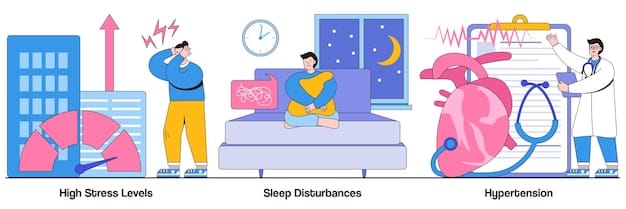Transcendental Meditation: Lower Blood Pressure in Just 20 Minutes?

Transcendental Meditation (TM), involving 20 minutes of practice twice daily, has shown promise in lowering blood pressure by approximately 5 points through promoting relaxation, reducing stress hormones, and improving overall cardiovascular health.
Could the key to lowering your blood pressure be as simple as sitting quietly for 20 minutes, twice a day? Transcendental Meditation (TM): Can 20 Minutes Twice Daily Really Lower Your Blood Pressure by 5 Points? This question has piqued the interest of health enthusiasts and researchers alike, and we’re here to explore the potential benefits of this ancient practice for modern well-being.
Understanding Transcendental Meditation (TM)
Transcendental Meditation, often referred to as TM, is a specific form of mantra meditation that originated in India. It involves the use of a mantra, a specific sound or word, to help the practitioner quiet the mind and achieve a state of deep relaxation.
The Core Principles of TM
Unlike other forms of meditation that may require focus or concentration, TM is designed to be effortless. Practitioners are taught to let the mantra guide them naturally into a state of restful alertness.
The technique aims to transcend the ordinary thinking process, allowing the mind to settle into a state of inner peace and calm. This is achieved through the consistent and proper use of the assigned mantra.
- Personalized Mantra: Each practitioner receives a specific mantra from a certified TM teacher.
- Effortless Technique: TM is practiced without concentration, control of the mind, or monitoring of thoughts.
- Regular Practice: Typically, TM is practiced for 20 minutes twice a day, usually in the morning and evening.
- Accessibility: TM is designed to be accessible to anyone, regardless of age, background, or experience.
Many find that the simplicity of the technique is one of its most appealing features. It doesn’t require special beliefs or lifestyle changes, making it easy to integrate into daily life.
In essence, understanding TM involves recognizing its focus on simplicity, effortlessness, and the use of a personal mantra to achieve deep relaxation and mental clarity.
The Science Behind TM and Blood Pressure
The idea that meditation can impact physical health, specifically blood pressure, has gained traction in recent years. Several studies have explored the link between Transcendental Meditation and its effects on cardiovascular health.
How TM Affects the Body
The regular practice of TM has been associated with a reduction in stress hormones like cortisol and adrenaline. High levels of these hormones can contribute to increased blood pressure, so reducing them can have a positive impact.
TM also promotes a state of relaxation that can help to dilate blood vessels, improving blood flow and lowering blood pressure. This relaxation response is often the direct opposite of the body’s “fight or flight” response, which can elevate blood pressure.

Key Research Findings
Several studies have shown that TM can indeed lower blood pressure. A meta-analysis published in the *Journal of the American Medical Association* found that TM was associated with significant reductions in blood pressure compared to other relaxation techniques.
The American Heart Association has also acknowledged the potential benefits of TM in reducing blood pressure, although they recommend it as a complementary therapy rather than a replacement for conventional medical treatments.
- Stress Reduction: Studies show a significant decrease in stress hormones, directly impacting blood pressure.
- Improved Blood Flow: TM promotes relaxation, which can lead to better blood vessel dilation.
- Consistent Results: Multiple studies support the idea that regular TM practice leads to lower blood pressure.
It’s important to note that while the research is promising, TM should be viewed as one component of a comprehensive approach to managing blood pressure, which may also include diet, exercise, and medication.
The confluence of research and anecdotal evidence suggests that TM could be a valuable tool in promoting cardiovascular health, particularly in managing and reducing blood pressure levels.
How to Learn Transcendental Meditation
Learning Transcendental Meditation typically involves enrolling in a structured course taught by a certified TM teacher. This is because the technique requires a specific mantra and personalized instruction to ensure it is practiced correctly.
The TM Course Structure
The course usually consists of several sessions spread over a few days. During these sessions, you’ll learn the core principles of TM, receive your personal mantra, and practice the technique under the guidance of a certified teacher.
The teacher will also provide follow-up support to ensure you are practicing TM correctly and effectively. This ongoing support is crucial for maintaining a consistent and beneficial practice.
Once you complete the initial course, you’ll have the tools and knowledge necessary to practice TM independently. However, continued support from your teacher is often available if you have questions or need guidance.

Resources for Finding a TM Teacher
The Transcendental Meditation organization maintains a directory of certified teachers who can guide you through the learning process. These teachers are trained to provide authentic and effective instruction in TM.
Websites like TM.org offer information on upcoming courses and teachers in your area. These resources can help you find a qualified instructor and get started with TM.
- Certified Teachers: Ensure you learn from a certified teacher to get the correct instruction.
- Structured Courses: TM courses provide a comprehensive understanding of the technique.
- Follow-Up Support: Ongoing support is crucial for maintaining an effective practice.
Learning TM from a certified teacher is a crucial step for ensuring the technique is practiced correctly and effectively. This form of guidance provides an authentic experience along with the support required for beneficial practice.
Finding a certified TM teacher and enrolling in a course is the best way to ensure you’re learning and practicing the technique correctly, setting you up for potential benefits such as lowered blood pressure and reduced stress.
Incorporating TM into Your Daily Routine
Once you’ve learned the Transcendental Meditation technique, incorporating it into your daily routine can be simple. TM is designed to be practiced for 20 minutes twice a day, typically in the morning and evening.
Creating a Consistent Practice
Finding a quiet and comfortable space is essential for your TM practice. This could be a corner in your bedroom, a peaceful spot in your garden, or any place where you can sit undisturbed.
Consistency is key to experiencing the full benefits of TM. Try to practice at the same times each day to establish a routine. Setting reminders in your phone can help you stay on track.
It’s also helpful to minimize distractions during your TM practice. Turn off your phone, let your family know you need uninterrupted time, and create an environment that promotes relaxation.
- Quiet Space: Find a location to help you minimize distractions and enhance relaxation.
- Consistent Time: This helps you make the meditation a habit.
- Minimize Distractions: Ensure you are undisturbed during your sessions.
Initially, integrating TM into your life requires some intention. However, with time, it can become an awaited part of your daily experience, benefiting both your stress levels and potentially your blood pressure.
The beauty of TM lies in its simplicity. Twenty minutes twice a day is often all it takes to introduce a significant positive change in overall health and well-being, particularly in managing blood pressure.
Additional Benefits of Transcendental Meditation
While lowering blood pressure is a significant potential benefit of Transcendental Meditation, the practice offers a range of other advantages that can positively impact your overall well-being.
Beyond Blood Pressure
TM has been shown to reduce stress and anxiety. By quieting the mind and promoting relaxation, TM can help to alleviate the symptoms of stress and create a greater sense of calm.
Many practitioners report improved sleep quality. The deep relaxation achieved through TM can help to reduce insomnia and promote more restful sleep.
TM can also enhance mental clarity and focus. By reducing mental clutter, TM can improve concentration and cognitive function.
- Stress Reduction: Aids in reducing both physical and mental stress through deep practice of relaxation.
- Improved Sleep: Facilitates deeper and more restful sleep through its calming effects on the nervous system.
- Better Focus: Enhances mental clarity and improves concentration.
Additionally, TM has been linked to improved emotional regulation. Practitioners often find they are better equipped to manage their emotions and respond to challenges with greater equanimity.
Although the impact on blood pressure is a key area of interest, the wide array of benefits associated with TM emphasize its holistic approach to wellness and its potential to enhance various aspects of life.
Addressing Common Concerns About TM
Like any practice or therapy, Transcendental Meditation can raise questions or concerns. Understanding these common points can help you make an informed decision about whether TM is right for you.
Addressing Doubts
One common concern is the cost of learning TM. TM courses are often more expensive than other meditation classes due to the personalized instruction and ongoing support provided by certified teachers.
Some people may also be skeptical about the need for a mantra or the claims made about TM’s effectiveness. It’s important to remember that TM is a specific technique with a distinct methodology, and its benefits are supported by scientific research.
Another concern is the time commitment. While 20 minutes twice a day may seem manageable, some individuals struggle to find the time in their busy schedules. However, many practitioners find that the benefits of TM far outweigh the time investment.
- Cost Concerns: Recognize the value of personalized professional instruction in TM.
- Skepticism: TM’s effects are supported by research, though individual experiences may vary.
- Time Commitment: Many find the benefits of TM worth the time investment.
It’s also important to have realistic expectations about what TM can achieve. While TM can be a valuable tool for managing blood pressure and improving overall well-being, it’s not a magic bullet. It’s most effective when combined with other healthy lifestyle choices and, if necessary, medical treatment.
By addressing these common concerns with accurate information, you can better decide if TM aligns with your health goals and lifestyle. Its potential impact on improved health is not just about lowering blood pressure, but also in enhancing holistic wellbeing.
| Key Point | Brief Description |
|---|---|
| 🧘 TM Basics | Mantra meditation to quiet the mind. |
| ❤️ Blood Pressure | Reduces stress, improving cardiovascular health. |
| 😴 Sleep Quality | Can lead to better, more restful sleep. |
| 🧑🏻🏫 Learning TM | Structured courses with certified teachers. |
Frequently Asked Questions
▼
Transcendental Meditation (TM) is a specific type of mantra meditation that involves using a sound or word to promote relaxation and quiet the mind, leading to improved mental and emotional well-being.
▼
TM helps reduce stress hormones, which in turn relaxes blood vessels and improves blood flow. This can lead to a decrease in blood pressure levels, promoting better cardiovascular health.
▼
To begin, locate a certified TM teacher near you through the Transcendental Meditation organization. They’ll guide you through the course, provide a personal mantra, and offer support for effective practice.
▼
TM usually requires 20 minutes of meditation twice daily, which is quite manageable for incorporating into a regular routine. This is a small amount of time to invest for experiencing the health benefits it can offer.
▼
Beyond reducing blood pressure, TM can lower stress and anxiety, foster improved sleep quality, and heighten mental clarity, contributing to all-around wellness and emotional stability for the meditator.
Conclusion
In conclusion, Transcendental Meditation (TM): Can 20 Minutes Twice Daily Really Lower Your Blood Pressure by 5 Points? While more research is always beneficial, the existing evidence suggests that Transcendental Meditation can be a valuable tool in managing blood pressure and improving overall well-being. With its simplicity, ease of practice, and potential for significant health benefits, TM may be worth exploring as part of a comprehensive approach to health and wellness.





